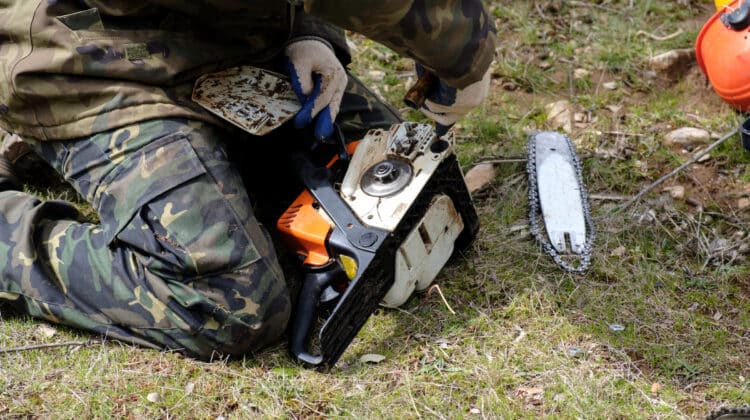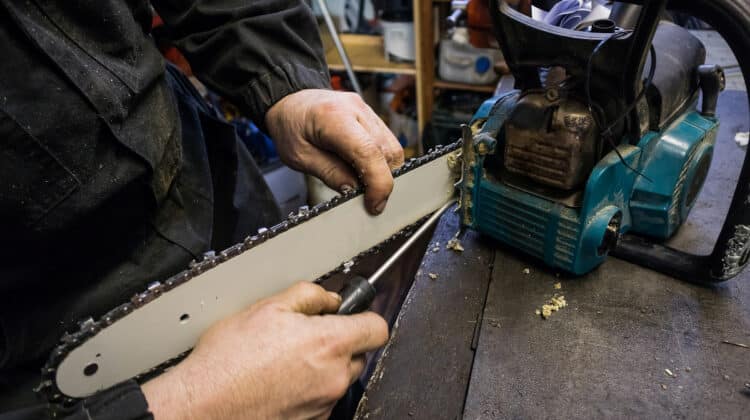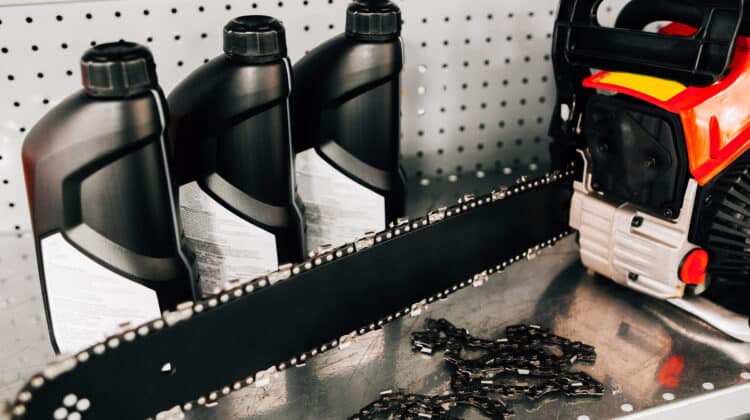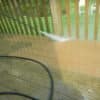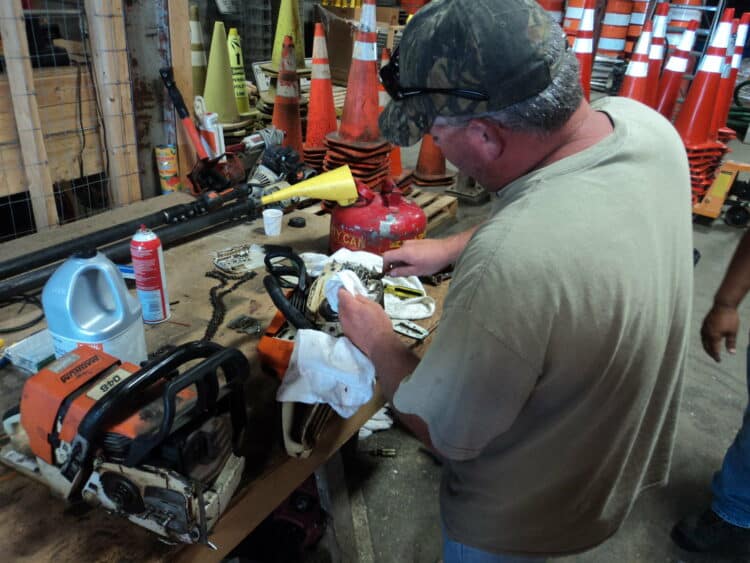
Cleaning a chainsaw is a maintenance task that a lot of people tend to ignore. But it may surprise you how much dirt your chainsaw may carry underneath all those moving parts.
Whether it’s sap or grease and sawdust, these materials can prevent your chainsaw from running efficiently.
But how do you know that it’s time to clean your chainsaw? Here are some pointers.
Table of Contents
How to know your chainsaw needs cleaning
- Your chainsaw is not cutting straight, and there is an increase in vibrations.
- Your chainsaw is no longer performing like it used to, and the parts are not as reliable either anymore.
- You keep struggling to stop the chainsaw.
- You have trouble starting the chainsaw.
The first issue may sound trivial, that is until your chain fails, and it flies straight into your face while working. When cutting wood, the cutting tooth chips off some wood and sawdust.
These go into the groove of the bar when the chain moves. And some fling in spaces between the chain links.
The bar oil and moisture can combine with the chips and sawdust to form sticky substances that will soak up new bar oil every time you try to lubricate your chain.
The next thing that happens is the chain starts running hot and keeps scraping against the bar rails. The scrapping results in burrs on either side of the bar edge, making it uneven.
That, as well as the increased friction, makes the chain bounce off the crooked edges, making the cuts appear curved.
The unreliable performance of the chainsaw may be due to other unwanted substances, including grease and sap clogging up the oiler holes, which secret the bar oil.
These substances also collect beneath the clutch cover.
The chain brake may fail to work when a lot of junk accumulates around it. That may also be the cause of a slip in the inertial brake.
More issues include a filthy air filter preventing you from starting the chainsaw. Or your spark plug failing to work due to accumulation of carbon (again, the engine won’t start due to the faulty spark plug).
And the internal parts of the engine failing to work due to sawdust collecting and causing the engine to run hotter than usual with little to no cooling.
The solutions to these problems are simple – clean your chainsaw often and inspect for the accumulation of unwanted substances.
Lastly, don’t forget to replace the spark plug after at least every 100 service hour.
Here is how to clean a chainsaw.
How do you deep clean a chainsaw?
Deep cleaning your chainsaw means thorough cleaning the various parts of the chainsaw. You will first need to take apart the components.
But before you start taking them off, you need to disconnect the power.
For electric chainsaws, unplug them from the power source. And drain all the gas and bar oil from gas chainsaws before you start work on them.
If you are using a battery (cordless) chainsaw, remove the battery before cleaning.
You then have to assemble all the necessary tools and cleaners before you start cleaning.
What do you use while chainsaw chain cleaning?
You will need:
- A degreaser like a WD40 spray
- A solvent like the Simple Green Pro Heavy Duty HD cleaner
- A wire brush
- A flathead screwdriver for cleaning the oiler hole
- Warm soapy water
- One inch paintbrush with a soft tip
- A cleaning tool for the bar groove or a putty knife
- A scrench
- A grease gun
- A flat hand file
- Air compressor
- Turpentine (ammonia solution will suffice)
How to take the parts of a chainsaw apart
It may sound like a lot of work right now, but it isn’t. All you need to do is locate the nuts on the side cover (there are two of them keeping the bar mounted on the powerhead) and loosen them with a scrench.
However, there are some precautions you need to take before you remove the clutch cover. One is ensuring that you disengage the chain brake first.
While other chainsaw models make it impossible to remove the clutch cover with the brake still on, others allow you to remove it, but the problem arises when you need to put it back on.
It gets impossible if you did not disengage the chain brakes.
That is why it is always best to first disengage the chain brakes (regardless of the model) before taking the cover off. You can then separate the chain and the bar and put them aside.
How to clean a chainsaw bar
You may need to use a degreaser to clean your chainsaw bar, depending on the amount of dirt it collected. That depends on how often you use the chainsaw.
Let’s start with the simplest one.
It’s easier to clean the bar if you only ever use the chainsaw to cut down a couple of trees over the weekend.
All you will need is some warm water with soap and a clean rag. Dip the rag in the warm water and wipe off all the grime and dirt from the bar.
For the hardened dirt and sawdust, you can use the wire brush to get it to scrape it off. That will be effective in cleaning the outermost parts of the bar and not within the bar rails.
You can use a putty knife (if you do not have one, fold a business card and use it) to clean the gunk from the bar rails.
Afterward, you can remove the debris that got into the oiler hole, blocking it using a screwdriver. Repeat the procedure for both oiler holes.
If you are still unable to get all the debris out, then an air compressor will do the trick and blow away the stubborn substances.
If you own a steam cleaner, you can set it at least 300 degrees Fahrenheit and use it. If not, hot soapy water will suffice.
Now let’s get to the more complex dirtier chainsaw bar.
If you are a professional and the chainsaw is your everyday tool, then the above procedure will not be as effective.
A high-pressure steam cleaner or an air compressor will suffice. If you lack these tools, then you can trust your solvent, in this case, a Simple Green Pro HD Heavy Duty Cleaner.
What makes it so effective is, it can act as both a degreaser and a solvent to get rid of all the dirt, grime, and sap from your chainsaw bar.
Plus, apart from it being multipurpose, it is also a biodegradable and non-corrosive cleaner.
How to use the solvent and wd40 degreaser to clean the bar
The first step is to make a solution of the concentrate with water (in one to three ratios) in a bucket.
Take both the clutch cover and the chainsaw bar and dip them in the solution. Let the two soak for at least 10 minutes before taking them out.
You need to use the wire brush again to scrape off the remaining dirt.
Once you feel like the bar is clean enough, dry it before spaying a light coat of wd40 degreaser and give it an hour to set. Use a clean rag to wipe off the degreaser.
But the job is not one yet. You need to check the edge of the rails to ensure that no burrs formed so that you get a straighter cut.
You can find out if any burrs are coming out of the bar rail by running your fingernails over the edges.
If there are sharp metal burrs, you need to file them even. A redresser toll works best to remove the burrs and give the bar rails a ninety degrees angle.
But if you do not have one of these, you can use your flat hand file.
How often should you change the chainsaw bar?
A worn-out bar turns from its original U shape to V. that will mean more side to side movement.
That means it’s time you get a new bar. You can also replace the bar once you realize that you are making crooked cuts, although you have a perfectly sharp chain.
How to best clean the chainsaw chain
The first step in getting your chain working as fine as new is soaking it in household ammonia solution for no less than 10 minutes and no more than 20.
But, it would be best if you took the necessary precautions while working with the ammonia solution. For instance, refrain from touching your eyes and skin during the procedure.
Plus, it’s always best to put on protective gear like glasses and gloves while handling ammonia. Lastly, ensure that your workshop has proper ventilation while working.
If your chainsaw chain isn’t that dirty (and you clean it regularly), then a scrape with a wire brush and a wipe with a clean rug will suffice.
Soaking it ensures that you get rid of all the unwanted stubborn substances, including resins, grease, and sawdust from chain links. It also does a pretty impressive job of dissolving the caked dirt and sawdust.
From there, scraping the chainsaw chain with a wire brush will quickly remove the remaining dirt.
If you are a professional and your chain accumulates too much pith and caked up sawdust, then you may need better tools to get rid of the substances.
Deep cleaning the chainsaw chain for professionals
As a professional, your chainsaw chain main needs more care because of all the dirt it collects daily. The first step here is fetching half a bucket of water and some household lye.
But before you start working, put on some thick working gloves and glasses for protecting your eyes.
Now, put some pellets of household lye on the cap of the container. And pour them into the bucket of water.
Mix the solution well but do not use your hands (the pellets can be very harmful to your skin).
Soak the chain in the solution for no less than twenty minutes or more if your chainsaw chain is filthy. However, the chain will rust if it stays in the solution for far too long.
Get a hooked tool to remove the chain from the solution. And keep it on the ground outside the workshop until the solution runs off of it.
You can hose down the excess solution and wait for the chain to dry before taking it back into the workshop.
As soon as it dries well, use several paper towels to wipe off the dirt. For the last but crucial step, dip the now clean chain in bar oil and wipe off the excess bar oil before storing it.
You will need to oil it again before reassembling it with the bar. That will prevent rust from forming.
If you are wondering about the types of oil to use, then a bar oil is an excellent choice.
How to clean the air filter in a chainsaw
For you to access the spark plug and air filter, you will have to remove the top cover. But do not forget to clean the top and the surrounding area to prevent dirt and debris from falling into the carburetor.
It is always a good practice to check and clean your air filter after at least 5 hours of use. The air filter may have moderate amounts of dust, and a gentle cleaning using a paintbrush with a soft tip will suffice.
If you have an air compressor, ensure you set it at low pressure before using it on the air filter. That way, you prevent the risk of damaging the air filter.
But if you have a non-oil and non-inflammable cleaner, you can use it to rinse the air filter under a running tap.
For a filthy air filter, make a solution of warm water and soap and clean it from the inside going out. You can then rinse the air filter in running water before drying it.
Suppose the air filter still appears foamy you can apply chain and bar oil and then squeeze out the excess bar oil.
How to clean the chainsaw’s cooling fins
If you do not have a bar cleaner tool (or a material made of soft metal), a screwdriver can come in handy in cleaning between the cooling fins.
You can check out the spaces between the fins on the cylinder head to ensure that all the gunk has come off.
You can then remove the grill cover for the starter rope. It may surprise you how much sawdust and other substances collect around the crankcase.
These, you can brush away.
How to clean the spark plug
It’s always wise to inspect your spark plug for any signs of it degrading. The perfect color for the electrode is coffee brown.
But a dark brown tip may mean it is time to replace the spark plug. Also, if the spark plug is full of baked-on dirt (probably, you took too long before cleaning it), cleaning it may not be the best solution.
To clean the spark plug (after every use if necessary), remove it and use a small wire brush to clean the electrode.
You may need to replace your spark plug if it has an incorrect gap size (too small or too large). That may prevent the spark plug from working.
And two, if it is wet fouled with gasoline. That can make the engine not to start.
You can refer to the owner’s manual for the right no. of replacement of the spark plug. And also, keep the gap size in mind while picking out the replacement.
How to clean an electric chainsaw
Cleaning an electric chainsaw is not different from how you wash the other chainsaws.
Like I mentioned earlier, you need to take the parts apart and scrub them separately (you can use the same procedure highlighted above).
Here are some extra pointers in cleaning the electric chainsaw;
Cleaning the electric motor/ powerhead of the chainsaw #1
It’s no secret that wood chips and sawdust will not miss out on a chance to creep inside the powerhead.
But instead of using water to clean it, you should you’re an air compressor to get all the dust and other unwanted substances out. Let’s get into more details.
You will need a one-inch soft tip paintbrush to clean the crankcase. The brush can get rid of all the dirt in the area. You then have a scrench to remove dust and dirt from hard to reach areas around the bar studs and clutch drum.
How to clean a chainsaw carburetor
Having a gummy residue inside the carburetor can make it impossible to start the engine.
Check the air intake parts of the carburetor for brownish residue. If you spot it, use a spray cleaner to get rid of it.
You then have to clean the needle valves by adding fuel (and cleaning agent) to the gas tank in gas models. Usually, that will dissolve any gummed up fuel deposits.
You can then pull the cord numerous times with intervals of rest to move the fuel and cleaning agent through the valves.
Your old fuel may condense and contaminate due to the moisture. It is therefore critical that you empty the gas tank and refill it with clean gas.
Can you pressure wash a chainsaw?
Pressure washing a chainsaw is not always the best option. It requires a lot of care and attention, and even the slightest of mistakes can damage the electric systems and the air filter leading to more expenses in replacing and repairs.
However, you can use high-pressure steam cleaners if your chainsaw has not had a thorough cleaning for a long time. And depending on how often you use your chainsaw, it may be necessary.
Either way, you need to be careful while using it to clean your tool. If there’s a better, less risky option, then it is best to use that one.
Can I clean chainsaw with brake cleaners?
Most people believe that a brake cleaner can severely damage the chainsaw, but that is not accurately true. Brake cleaners are non-corrosive to metal, but it may be too much for plastics.
Besides, brake cleaners dry off almost immediately, leaving little to no residue. The worst it could do is dull your paint or scrape a bit of it.
Reassemble the parts
You can now mount the dry chain on the bar and reattach the covers (both starter cord and engine covers).
It would be best if you were careful with how you mount the chain. If you put it in the wrong direction, it may cause a lot of damage.
You then have to mount the bar on the studs and put the clutch cover in place before tightening the nuts.
To adjust the tensioning screw to prevent the chain from sagging (but not too tight either), you need to hold up the bar using the tip of the nose.
The last step involves tightening the bar nuts with a scrench and refill them with the bar oil and gas.
Final thoughts
Cleaning your chainsaw will enhance its lifespan and improve performance.
And it will even ensure that you do not have to replace parts often since you are taking precautions to ensure they are in top-notch condition.
The highlighted steps can help guide you in dissembling the parts, properly clean each component of the chainsaw before reassembling them.
You can also use the different tips to ensure that you are safe while handling the solvents and degreasers. And get as much dirt out of your chainsaw to make it sparkling new once more.
But even after cleaning and your chainsaw is not performing any better or starting, then it may be time to take it to the mechanic shop.
A good repair and replacement of worn-out parts can ensure that your chainsaw is working excellently again.
If not, you may need to upgrade the tool and get a new one. You can never run out of options for the best chainsaws considering your needs.
You can get a top-rated chainsaw, especially if you are a professional, or an all-around chainsaw or a lightweight chainsaw where you have the choice of smaller or bigger models.
Or if you are a homeowner, then a homeowner chainsaw may suffice for you.
